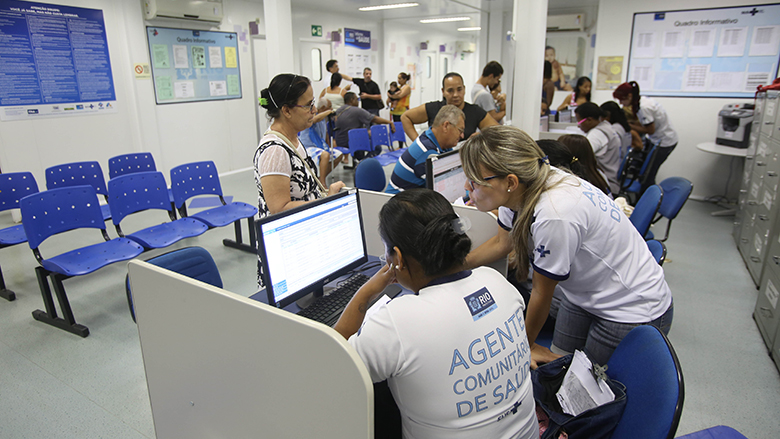Challenge
Brazil first introduced the PSF in 1994 as the government’s main strategy for extending primary health care to underserved populations. In 1998, the government implemented major health reforms, changing the organization, financing, and provision of health services. States and municipalities supported the reforms but lacked the managerial capacity needed to show results. The PSF was designed to improve health outcomes through a community-based, outreach-oriented primary health care model provided by multiple professional health teams to mostly underserved rural areas and small municipalities, and later to 250 urban municipalities (under 100,000 inhabitants), where over 60 percent of Brazil’s population resided.
Despite several achievements, the PSF faced several challenges:
(i) low productivity of health teams,
(ii) difficulties in converting traditional primary care units to the family health approach,
(iii) low prestige of family health practice among physicians,
(iv) poor quality of some health professionals,
(v) weak referral systems,
(vi) lack of information on quality of care, efficiency and costs, and
(vii) absence of performance orientation at the service delivery level.
Solution
The Family Health Extension Adaptable Program Lending (APL) helped expand and consolidate coverage of the PSF, introducing performance-based financing and management arrangements into the government’s transfers to the municipal and state levels, while strengthening the Ministry of Health’s capacity to monitor and evaluate PSF health services. Significant up-front analysis carried out during preparation informed the design of a performance-based disbursement mechanism and uniform fiduciary and reporting arrangements that applied to the entire PSF investment.
Results
The project met the end of Program outcome targets by its mid-term review. Infant mortality had been reduced from 17.8 per 1,000 live births in 2003 to 13.9 in 2011, and per capita contacts with primary care providers had increased from 1.4 in 2003 to 1.6 in 2011. At the time, PSF coverage in municipalities under the Project for the Expansion and Consolidation Family Health (PROESF 2) had increased from 33.8 percent of the population in 2006 to 39.5 percent in 2011, exceeding the target of 37 percent. By project completion, although other factors were likely at play (increased access to safe water, quality food and education, and a reduction in poverty), infant mortality had been reduced further to 12.7 per 1,000 live births in 2013. The per capita contacts with primary care providers, however, had increased to 1.8 in 2012 but then began a downward trend, decreasing to 1.5 in 2014, falling short of the target. PSF coverage had been expanded to 48.2 percent of the population. In addition, studies by the Ministry of Health showed that PSF’s population coverage increased at a faster pace in the 187 participating municipalities than in those that had not participated.
Bank Group Contribution
The Family Health Extension Adaptable Program Lending was originally designed as a three-phase, seven-year US$550 million program. A US$68 million loan in support of the first phase of the program was approved in March 2002. A US$83.45 million loan in support of its second phase was approved in April 2008, of which US$34.7 million were spent. The third phase was never considered in view of the Government’s evolving priorities and programs, which made the relevance of continued IBRD support modest mid-way through implementation of the program’s second phase. Although Bank financing represented less than five percent of the PSF’s total costs, it provided significant leverage to affect the program’s design and functioning.
Partners
There were no external partners supporting the PSF. Nevertheless, there was strong partnership and coordination among Ministry of Health, state and municipal Secretariat’s of Health and the Bank, both in the design of the program and its early implementation.
Moving Forward
Despite subsequent changes in policy, funding, and government priorities, the new programs continue to build upon the PSF’s performance orientation, including its quality dimensions. A new public health care policy (PNAB) approved in October 2011 provided directives and guidelines on primary health. New initiatives were introduced, including changes in federal financing arrangements to include both equity and quality as criteria. Resources allocated to primary health more than doubled, from R$9.8 billion in 2010 to R$20 billion in 2014. With increased funding and new programs, the PSF remains a preferred delivery model, albeit one of several programs. The PSF’s most significant contribution was the performance-based financing modalities for linking federal transfers to results that have been institutionalized in Brazil’s public health care system.
Beneficiaries
The project was to support further coverage extension exclusively in 187 municipalities with over 100,000 inhabitants that had participated in the first phase. About 38 percent of those in the poorest income quintile lived in urban areas, and health indicators among the urban poor were as bad as or worse than indicators among the rural poor. The Project for the Expansion and Consolidation Family Health (PROESF 2) would also support states to provide technical assistance, training and managerial support to small municipalities in rural areas, and to the Ministry of Health in strengthening the program’s systems and its ability to provide support to states and municipalities.
